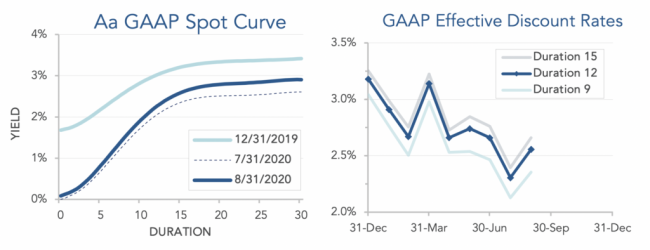
August 2020 Pension Finance Update
Pensions enjoyed their best month of the year in August, driven by higher stock prices and higher interest rates. Both model plans we track[1] gained ground last month, with Plan A improving 6% and Plan B gaining 1% during August. For the year, Plan A is still down more than 3% and Plan B is down 1% through the first eight months of 2020:

Assets
Stocks extended their winning streak to five consecutive months, led by the NASDAQ, which has enjoyed a return of more than 30% this year. A diversified stock portfolio is now up almost 7% for 2020, after being down more than 20% at the end of the first quarter.

Interest rates climbed 0.25% last month. As a result, a diversified bond portfolio lost 1%-4% in August but remains up 10%-12% through the first eight months of 2020, with long duration and Treasuries outperforming.
Overall, our traditional 60/40 portfolio gained 3% in August and is now up more than 7% for the year, while the conservative 20/80 lost less than 1% last month but remains up almost 9% through the first eight months of 2020.
Liabilities
Pension liabilities (for funding, accounting, and de-risking purposes) are driven by market interest rates. The first graph below compares our Aa GAAP spot yield curve at December 31, 2019 and August 31, 2020, and it also shows the movement in the curve last month. The second graph below shows our estimate of movements in effective GAAP discount rates for pension obligations of various duration during 2020:

Corporate bond yields rose 0.25% last month, welcome news for pension sponsors that reduced pension liabilities 2%-4%. Through the first eight months of 2020, liabilities have increased 9%-13% for most plans, with long duration plans seeing the largest increases.
Summary
It is astonishing, given the social and economic backdrop, how pensions have managed to claw back most of the losses suffered during the first quarter of 2020. The graphs below show the movement of assets and liabilities for our two model plans during the first eight months of the year:

Looking Ahead
Pension funding relief has reduced required plan funding since 2012, but under current law, this relief will gradually sunset. Given the current level of market interest rates, it is possible that relief reduces the funding burden through 2030, but the rates used to measure liabilities will move significantly lower over the next few years, increasing funding requirements for pension sponsors that have only made required contributions.
2020 experience, if it persists, will not increase required contributions until 2022, compounding higher funding requirements due to the fading of funding relief. There is some chance we get more relief this year, but at this point it’s too soon to say for certain.
Discount rates moved higher last month. We expect most pension sponsors will use effective discount rates in the 2.3%-2.7% range to measure pension liabilities right now.The table below summarizes rates that plan sponsors are required to use for IRS funding purposes for 2020, along with estimates for 2021. Pre-relief, both 24-month averages and December ‘spot’ rates, which are still required for some calculations, such as PBGC premiums, are also included.

[1]Plan A is a traditional plan (duration 12 at 5.5%) with a 60/40 asset allocation, while Plan B is a largely retired plan (duration 9 at 5.5%) with a 20/80 allocation with a greater emphasis on corporate and long-duration bonds. We assume overhead expenses of 1% of plan assets per year, and we assume the plans are 100% funded at the beginning of the year and ignore benefit accruals, contributions, and benefit payments in order to isolate the financial performance of plan assets versus liabilities.
